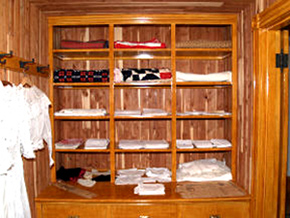March 19, 2007
How Valuable Are Cedar Closets For Protecting Your Clothes?

By Michael D. Shaw
Since this week marks the arrival of spring (March 20th at 8:07 PM EDT), many homeowners will begin their annual ritual of cleaning out closets and presumably safeguarding their winter clothes from dreaded moths, mildew, and other threats. What better time to discuss the enduring myth that cedar closets are the best way to protect your delicate woolen items?
To be sure, the use of cedarwood oil for such purposes as embalming, cosmetics, perfumery, and to repel insects dates back to ancient Egypt. Nowadays, though, most “cedarwood” essential oil is derived from juniper Juniperus virginiana, a coniferous evergreen known as Eastern Redcedar.
Interestingly, cedarwood oil was initially registered in 1960 as a pesticide to repel moths from clothing. However, following the formalities of EPA reregistration, in which considerable scientific work was done on its safety, the Agency deregulated cedarwood oil in 1996. As such, manufacturers of products using the oil are no longer required to register them as pesticides.
Besides the properties of its essential oil, there was always great prestige connected to its wood. King Solomon himself chose this lumber to build his temple, presumably because its fragrance was believed to lead worshipers closer to God.
In a sense, present day cedar closets are a bit of a throwback. While they are still expensive, and may in some cases increase your home’s value, there are certainly better and easier ways to protect your sensitive clothing.
First of all, don’t compare pesticide activity in a large closet area with the efficacy observed in cedar chests. The chests, after all, are small and are tightly closed, and being tightly closed no doubt helps keep away the moths! If cedarwood oil is going to work against pests, it must be present at a relatively high concentration—and this means higher than just being enough to smell. Even the more toxic old-fashioned moth balls are most effective when sealed up with the garments.
Notwithstanding that cedar lumber loses most of its oil fragrance a few years after cutting (sanding can help prolong the odor), maintaining a pesticide-level concentration in the closet presents various drawbacks.
Even if you were willing to somehow seal up your closets, you would be inviting mold and mildew. Without adequate ventilation, those pungent cedarwood oil fumes could escape to the bedroom. Indeed, many who think they love the aroma dream that they are stuck in a hamster cage, within a few weeks. Infants, the elderly, and those suffering from asthma can have problems with the fumes.
But, if you are undeterred by all of this and want to cedarize your closets, what can you expect?
A recent article in the Chicago Tribune notes that the material of choice—¾-inch-thick boards—has become an expensive special order at most suppliers. Alternatives include thin cedar planks (at half the thickness of the boards) and 4-by-8-foot sheets, often only ¼-inch-thick. The sheets, though, have a flakeboard look, and may not be the most aesthetically pleasing approach.
Ironically, after giving its readers a fairly comprehensive treatment of the subject, the article concludes:
While aromatic red cedar smells sweet and fresh to us, its aromatic oils repel moths, cockroaches, and silverfish. But cedar is not insect proof. In fact, dry-cleaning and then sealing clothes in garment bags probably offers better protection.
Also recommended are the inexpensive, stackable 17 quart (16.1 liter) plastic storage boxes, that snap shut, and are available at most home stores. You might even want to empty your closets and caulk any obvious floor leaks, bearing in mind that determined moths will definitely get into your closets via windows and doors.
When that happens, your unprotected clothing will reflect Murphy’s moth law: Only the most expensive garments will be attacked.

